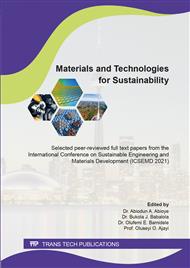[1]
S.O. Bitire, T.C. Jen, and M. Belaid, Transesterification of parsley seed oil using a green catalyst: considering the optimization process and modeling, Int. J. Sustain. Energy. (2021).
DOI: 10.1080/14786451.2021.1890737
Google Scholar
[2]
B.R. Moser, Biodiesel production, properties, and feedstocks', In Vitro Cellular and Developmental Biology - Plant. 45, 3(2001) 229–266.
DOI: 10.1007/s11627-009-9204-z
Google Scholar
[3]
U. Rashid, M. Ibrahim, S. Yasin, R. Yunus, Y. H. Taufiq-Yap, and G. Knothe, Biodiesel from Citrus reticulata (mandarin orange) seed oil, a potential non-food feedstock, Ind. Crops Prod., (2013).
DOI: 10.1016/j.indcrop.2012.12.039
Google Scholar
[4]
H. Zhang, F. Chen, X. Wang, and H. Y. Yao, Evaluation of antioxidant activity of parsley (Petroselinum crispum) essential oil and identification of its antioxidant constituents, Food Res. Int. (2006).
DOI: 10.1016/j.foodres.2006.03.007
Google Scholar
[5]
A.A.J.J. Aljanaby, Antibacterial activity of an aqueous extract of Petroselinum crispum leaves against pathogenic bacteria isolated from patients with burns infections in Al-najaf Governorate, Iraq, Res. Chem. Intermed. (2013).
DOI: 10.1007/s11164-012-0874-5
Google Scholar
[6]
A. Mert and M. Timur, Essential oil and fatty acid composition and antioxidant capacity and total phenolic content of parsley seeds (Petroselinum crispum) grown in Hatay Region, Indian J. Pharm. Educ. Res. (2017).
DOI: 10.5530/ijper.51.3s.63
Google Scholar
[7]
M. J. Ramos, C. M. Fernández, A. Casas, L. Rodríguez, and Á. Pérez, Influence of fatty acid composition of raw materials on biodiesel properties, Bioresour. Technol. (2009).
DOI: 10.1016/j.biortech.2008.06.039
Google Scholar
[8]
S.O. Bitire, T.C. Jen, and M. Belaid, Synthesis of beta-tricalcium phosphate catalyst from Herring fishbone for the transesterification of parsley seed oil, Environ. Technol. (United Kingdom). (2021).
DOI: 10.1080/09593330.2021.1916094
Google Scholar
[9]
J. Boro, A. J. Thakur, and D. Deka, Solid oxide derived from waste shells of Turbonilla striatula as a renewable catalyst for biodiesel production, Fuel Process. Technol. (2011).
DOI: 10.1016/j.fuproc.2011.06.008
Google Scholar
[10]
I. M. Rizwanul Fattah et al., State of the Art of Catalysts for Biodiesel Production, Frontiers in Energy Research. 8(2020).
Google Scholar
[11]
M. Kouzu, T. Kasuno, M. Tajika, Y. Sugimoto, S. Yamanaka, and J. Hidaka, Calcium oxide as a solid base catalyst for transesterification of soybean oil and its application to biodiesel production, Fuel. 87,12 (2008) 2798–2806.
DOI: 10.1016/j.fuel.2007.10.019
Google Scholar
[12]
K. Prasertsit, P. Phoosakul, and S. Sukmanee, Use of calcium oxide in palm oil methyl ester production', Songklanakarin J. Sci. Technol. 36, 2(2014) 195–200.
Google Scholar
[13]
S. Ismail, A.S. Ahmed, R. Anr, and S. Hamdan, Biodiesel Production from Castor Oil by Using Calcium Oxide Derived from Mud Clam Shell, J. Renew. Energy. 1 (2016), 1–8.
DOI: 10.1155/2016/5274917
Google Scholar
[14]
A. Bouaid, R. Vázquez, M. Martinez, and J. Aracil, Effect of free fatty acids contents on biodiesel quality. Pilot plant studies, Fuel. (2016).
DOI: 10.1016/j.fuel.2016.01.018
Google Scholar
[15]
T.G. Kudre, N. Bhaskar, and P. Z. Sakhare, Optimization and characterization of biodiesel production from rohu (Labeo rohita) processing waste, Renew. Energy. (2017).
DOI: 10.1016/j.renene.2017.06.101
Google Scholar
[16]
D. Qasim, Y. I. Abdul-Aziz, and Z. T. Alismaeel, Biodiesel from fresh and waste sunflower oil using calcium oxide catalyst synthesized from local limestone, Res. J. Chem. Environ. (2019).
Google Scholar
[17]
G.Y. Chen, R. Shan, J.F. Shi, and B. B. Yan, Transesterification of palm oil to biodiesel using rice husk ash-based catalysts, Fuel Process. Technol. (2015).
DOI: 10.1016/j.fuproc.2015.01.005
Google Scholar
[18]
F. X. Yang, Y. Q. Su, X. H. Li, Q. Zhang, and R. C. Sun, Preparation of biodiesel from Idesia polycarpa var. vestita fruit oil, Ind. Crops Prod. 29(2009) 2–3. 622–628.
DOI: 10.1016/j.indcrop.2008.12.004
Google Scholar
[19]
B.P. Lim, G.P. Maniam, and S.A. Hamid, Biodiesel from adsorbed waste oil on spent bleaching clay using CaO as a heterogeneous catalyst, Eur. J. Sci. Res. 33,2(2009) 347–357.
Google Scholar
[20]
A. Buasri, N. Chaiyut, V. Loryuenyong, P. Worawanitchaphong, and S. Trongyong, Calcium oxide derived from waste shells of mussel, cockle, and scallop as the heterogeneous catalyst for biodiesel production, Sci. World J. (2013).
DOI: 10.1155/2013/460923
Google Scholar
[21]
C. Samart, P. Sreetongkittikul, and C. Sookman, Heterogeneous catalysis of transesterification of soybean oil using KI/mesoporous silica, Fuel Process. Technol. 90, 7–8(2009) 922–925.
DOI: 10.1016/j.fuproc.2009.03.017
Google Scholar
[22]
T. Long, Y. Deng, S. Gan, and J. Chen, Application of choline chloride·xZnCl2 ionic liquids for preparation of biodiesel, Chinese J. Chem. Eng. 18, 2(2010) 322–327. doi:10.1016/ S1004-9541(08)60359-6.
DOI: 10.1016/s1004-9541(08)60359-6
Google Scholar


